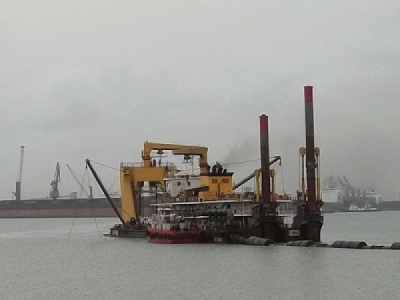
Posted on January 10, 2017
By Partha Basistha, Fairplay
Paradip Port is in the second phase of a major capital dredging project. The state-managed port in the mineral-rich state of Odisha, India, on the east coast of the Bay of Bengal, is carrying out this second round of dredging to complement a new bulk terminal.
These projects form part of an expansion programme to increase its handling capacity and allow it to accommodate bigger vessels.
Paradip is considered a major port and serves a large number of power, mineral, and oil refinery industries located in its vast hinterland spreading over states of eastern, central, northern, and southern India.
Private Indian marine construction firm Dharti Dredging & Infrastructure was awarded the contract and work is targeted to be finished by April 2017.
The first phase
Dharti was also involved in the first phase of dredging, which was completed in 2015. This involved capital dredging the 345 m-long South Oil jetty of the newly commissioned, 15 million tonne, refinery for the Indian Oil Corporation Ltd (IOCL). One cutter section dredger was deployed to dredge 2.3 million m³ of sand to create a draught of 17 m. Now IOCL can handle crude and finished product tankers from 1,20,000–2,00,000 dwt at the jetty.
The jetty, dedicated to processing IOCL oil, was commissioned in 2015. It is the first coastal refinery built on a greenfield site in India and stands on 322 cast-in-situ reinforced cement concrete piles.
Constructed in accordance to the guidelines of the Oil Industry Safety Directorate of India, the jetty has elaborate firefighting arrangements in place. These include: four 20 m-high fire tower monitors with water a pumping pressure of 4,500 litres/minute; four jumbo water curtains of 0.6 m with 6,000 litres/minute water pumping pressure; four base monitors of 1.6 m of 4,500 litres/minute; and, seven double-headed hydrants of 1.6 m with 4,500 litres/minute capacity.
Further, to prevent a fire hazard at the jetty there are two fire stations, one on the north and the other on the south side of the refinery, which is located inside the port harbour area, on the seashore, close to the entrance channel of the port.
Dry bulk handling
Tenders for the second dredging project, valued at USD21 million, were awarded in October 2015. The work involves dredging from 14 m to 17.1 m for a new dry bulk terminal.
According to Ramchandra Rao, chief engineer at Paradip Port, “Setting up of the new [dry] cargo terminals supported by the required dredging will enable the port to raise its capacity to 252 million tonnes by 2020”.
Paradip Port currently has 14 berths to handle bulk cargoes in the inner harbour, with draught levels of between 13 and 14 m.
An estimated 7 million m³ of sand will be dredged in the second phase of deepening work, taking place in the inner harbor near the entrance channel. Three cutter suction dredgers have been deployed by Dharti for the job.
One dredger has been placed at the southern side of the harbour and another two on the northern side. Placement of the dredger on the southern side, coupled with the pipes for disposing the dredged material, posed a major challenge as the pipe carrying dredged materials from the vessel had to be laid through the busy entrance channel of the port.
According to MVPH, Rao, vice-president and head of business development at Dharti Dredging, “Laying the pipes for disposing of the materials was a major impediment foreseen by the Paradip Port authorities and by us. However, we had successfully dealt with the impediment earlier when we assisted Dredging Corporation of India to dispose of dredged materials through pipes from its cutter suction dredgers for the port deepening in 1992. [Our] ability and experience to deal with the issue made [us] eligible for the second contract.”
Pipe problems
Dharti put down 570 m of pipes under the entrance channel within two days, during which time the channel was closed. Rao said major underwater water obstructions were encountered during excavation and pipe-laying as there were high volumes of steel pipes and breakwater material left at the channel following construction of the South Oil jetty.
He concluded, “The dredged material is being shore-dumped for beach nourishment because there is heavy beach erosion at Paradip due to the heavy east coast monsoon.”
According to the port there is a proposal to develop a further facility with a draught of up 22 m to handle Capesize vessels. This will form part of the government’s Sagamarla programme of investment around the coastline of India to link the country’s vast hinterland with ports.
Source: FairPlay





